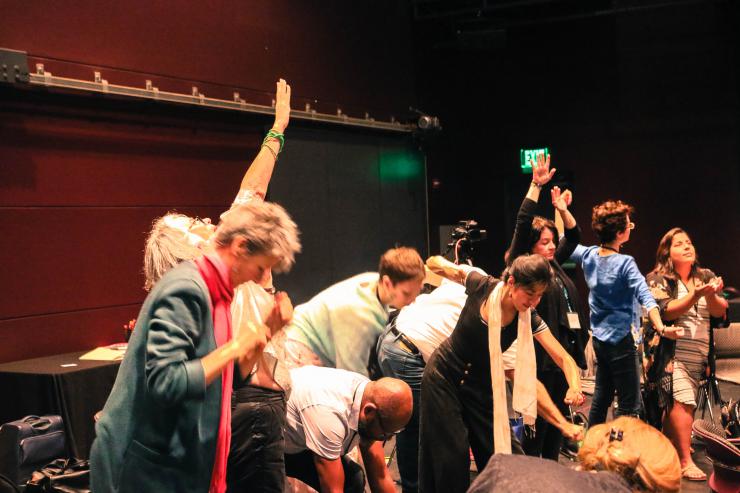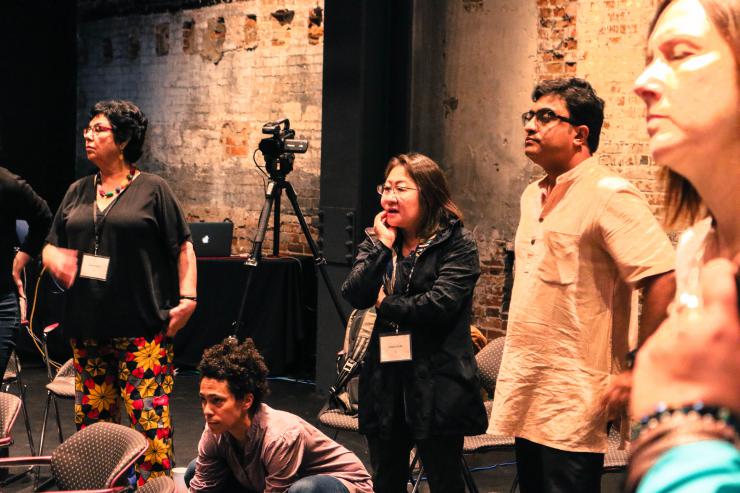The Possibility of Generative Futures Through Embodied Practice
This is already the fourth year and the eighth installment of the Theatre in the Age of Climate Change series. I wish this milestone was cause for celebration—the work being done at this intersection is certainly deserving of praise—but the truth is, every step forward towards a more just and sustainable world is met with our world leaders pulling us several steps back. So short of celebrating, let’s at least acknowledge the fearless and dedicated artists who are leading the way in this all too real existential battle. In this article, Annalisa Dias discusses ways theatre could bring together, and embody, the fight against climate change and the need for climate justice. —Chantal Bilodeau
In June 2018, I had the privilege to attend the Theatre in the Age of Climate Change convening hosted by HowlRound. It was a full weekend. While I was there I was grateful to reconnect with Jayeesha Dutta, who is a fierce advocate, artist, and cultural organizer. She and I first met while organizing for the 2017 People’s Climate March, but the HowlRound convening was the first time we really got to learn more about each other’s work.
During the convening, we were given the space to facilitate an activity using dynamized image theatre (from Theatre of the Oppressed) to ask convening participants to embody the concept of a Just Transition.
We asked convening participants first to embody the idea of “extraction” by making a static image using their bodies. Next, we asked everyone to look around the room at all of the varied images we had made and then, using words to name them, reflect back some of the common themes. We made images of crushing, tension, scratching, harm, pain, images with sharp edges and angles. After everyone shook those images off, Jayeesha and I asked everyone to make a new image of the idea “generative.” We repeated the process of naming and reflection, and this time the common themes included lightness, peace, softness, offering, circles, images with gentle curves and upward focus. In the final step of dynamizing these images, we asked everyone to try to find a way, using a simple movement phrase, to transition from their first image to their second image. The goal of the activity is to use the body to explore possible solutions in the move from extractive to generative economies. Rather than spending ages and ages talking about theoretical hindrances in the work of moving toward climate justice, why not use the tools of the theatre in visioning possible futures? This is what we’re good at!
[W]e must center the voices, stories, and experiences of frontline communities who are most deeply and already impacted by the changing climate, including indigenous peoples, low-income communities, and communities of color.

What Is a Just Transition?
The concept of a Just Transition has been developed over the last thirty years. Briefly, it’s a framework that seeks to unify the environmental movement with the labor movement. In many of the climate movement spaces that I’ve personally been involved with, folks prioritize talking about “climate justice” in place of just the problems of “climate change.” The reason for this important nuance has to do with how, historically, the US and international climate movements have been focused on the politics of environmental conservation at the expense of social movements. In many ways, conservationist movements are rooted in anti-indigenous and colonial white supremacist ideology that conceptualizes the environment or “nature” as separate from human activity and relies on the myth of the wilderness in determining environments deemed worthy of saving.
So instead, we seek to transition away from extractive and exploitative economies by using the framework of a Just Transition. This means we must center the voices, stories, and experiences of frontline communities who are most deeply and already impacted by the changing climate, including indigenous peoples, low-income communities, and communities of color. As theatremakers, we know deeply that stories matter. In the face of the climate crisis, this has never been more true. For more information, see this helpful definition from the Climate Justice Alliance.

What is Groundwater Arts?
Ok, but now you might be thinking, “Sure that all sounds great, but what do we do about this?” Or, “Easier said than done.”
Well, right. I get that.
I’ve been working (individually and together with my frequent collaborator Anna Lathrop) over the last several years with other artists and with arts institutions on a number of projects related to decolonizing practices and climate justice. Thanks to a seed of inspiration from the HowlRound Convening, Anna and I have made the leap into launching a new consulting and producing collaborative called Groundwater Arts.
We’re an artist-led collaborative, and we want to begin working with like-minded artists to build a generative future through a just and equitable transition away from the exploitation of people and the planet. We hope to create long-term partnerships, collaborations, and resources that foster accountable theatremaking and powerful alternatives to structural racism, oppression, and inequity in the face of climate change. This vision is directly inspired by the groundwork laid by Storyshift to articulate principles and praxis for this kind of work.
I’ve continually noted a critical gap between the work we’re doing as a field to dismantle white supremacy and the work we’re doing to build more sustainable, green ways of working. These two efforts are not and cannot be separate.
Basically, this means we’ll help you figure out how to implement programs and practices (or assess the ones you already have in place) to integrate a decolonizing framework with a vision for a sustainable future. We’re excited to work with individual artists, arts institutions, and service organizations who believe, as we do, that the arts have a crucial role to play in shifting the narrative around the climate crisis.
Start with the ground. Give thanks for the water. Seed a just future.
A Challenge to Theatremakers
In many ways, Groundwater Arts also comes from another seed. Over the last few years, I’ve continually noted a critical gap between the work we’re doing as a field to dismantle white supremacy and the work we’re doing to build more sustainable, green ways of working. These two efforts are not and cannot be separate.
If you haven’t read Naomi Klein’s This Changes Everything, I’d highly recommend it. She does a phenomenal job of explaining how the global movements for racial justice, indigenous sovereignty and land rights, equitable labor, and the environment are poised to come together in the face of the climate crisis. This is urgent and hopeful work.
So, in the face of the climate crisis (which I see as directly linked to 500 years of colonial violence and white supremacy), here are some steps that I think we, either as individual artists or folks working in institutional roles, can take:
- Adopt the StoryShift principles around community-accountable storytelling (props to HowlRound for signing on already!)
- Center the stories and experiences of frontline communities
- Dismantle white supremacy in all its forms (decolonize!)
- Re-examine our funding structures and divest from fossil fuel interests
- Use our art practice (or institution) to imagine a more generative, sustainable future
- Get involved with the new USDAC Bureau of Energy, Power, and Art (EPA)
My hope is that these will help us begin to tie together our critical frameworks and align our values with our practice around creating a more just and equitable future.



Comments
The article is just the start of the conversation—we want to know what you think about this subject, too! HowlRound is a space for knowledge-sharing, and we welcome spirited, thoughtful, and on-topic dialogue. Find our full comments policy here